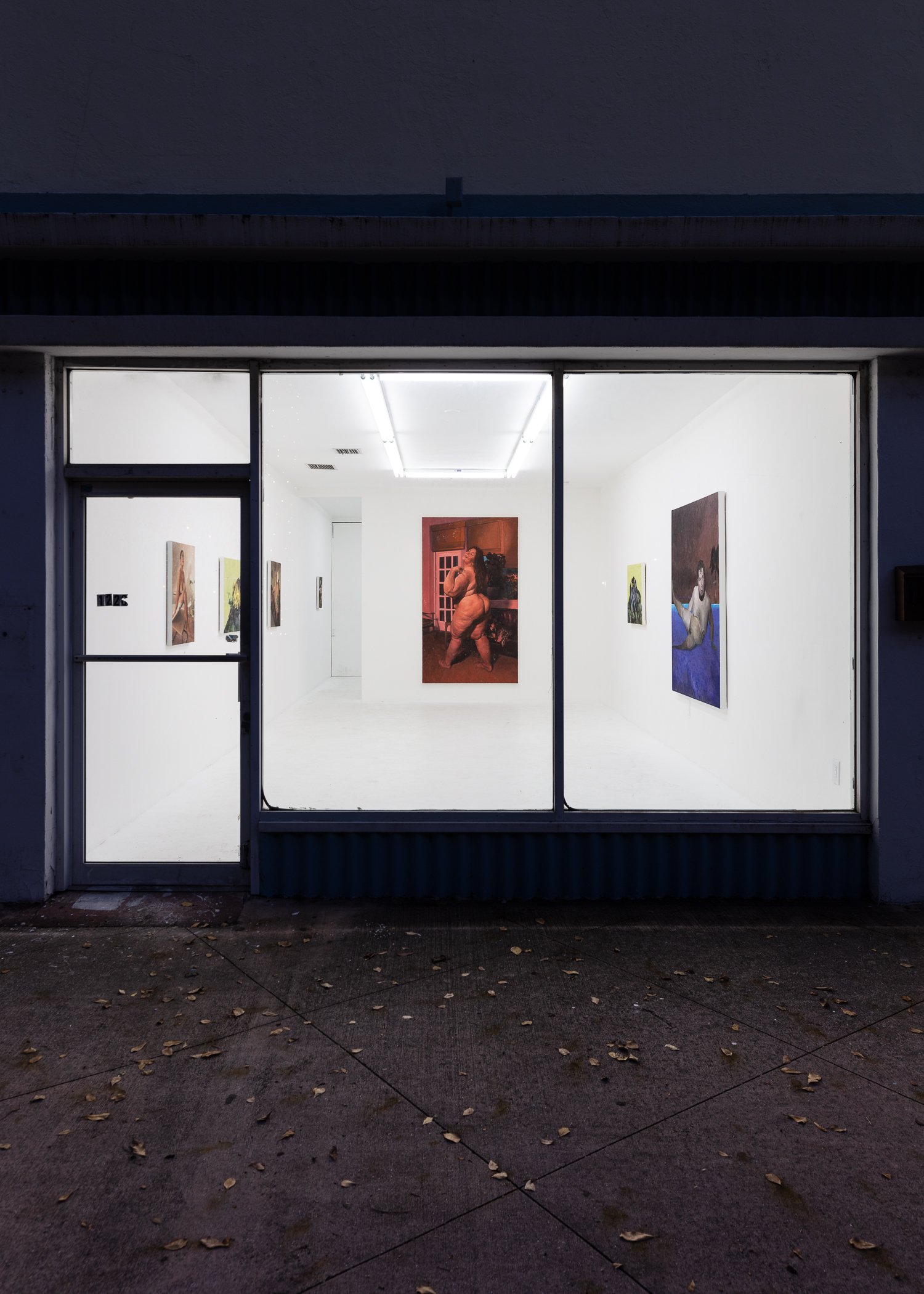
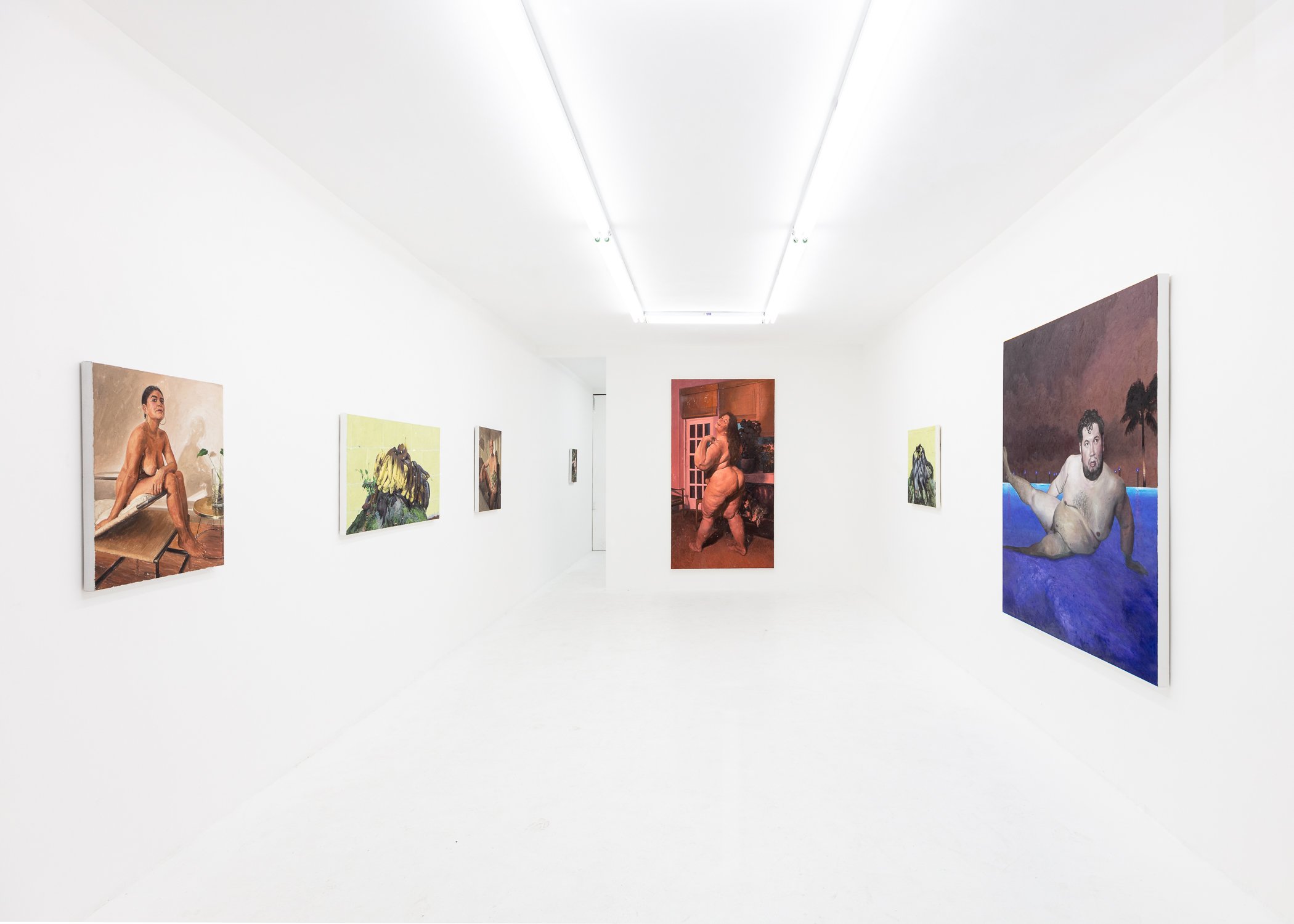
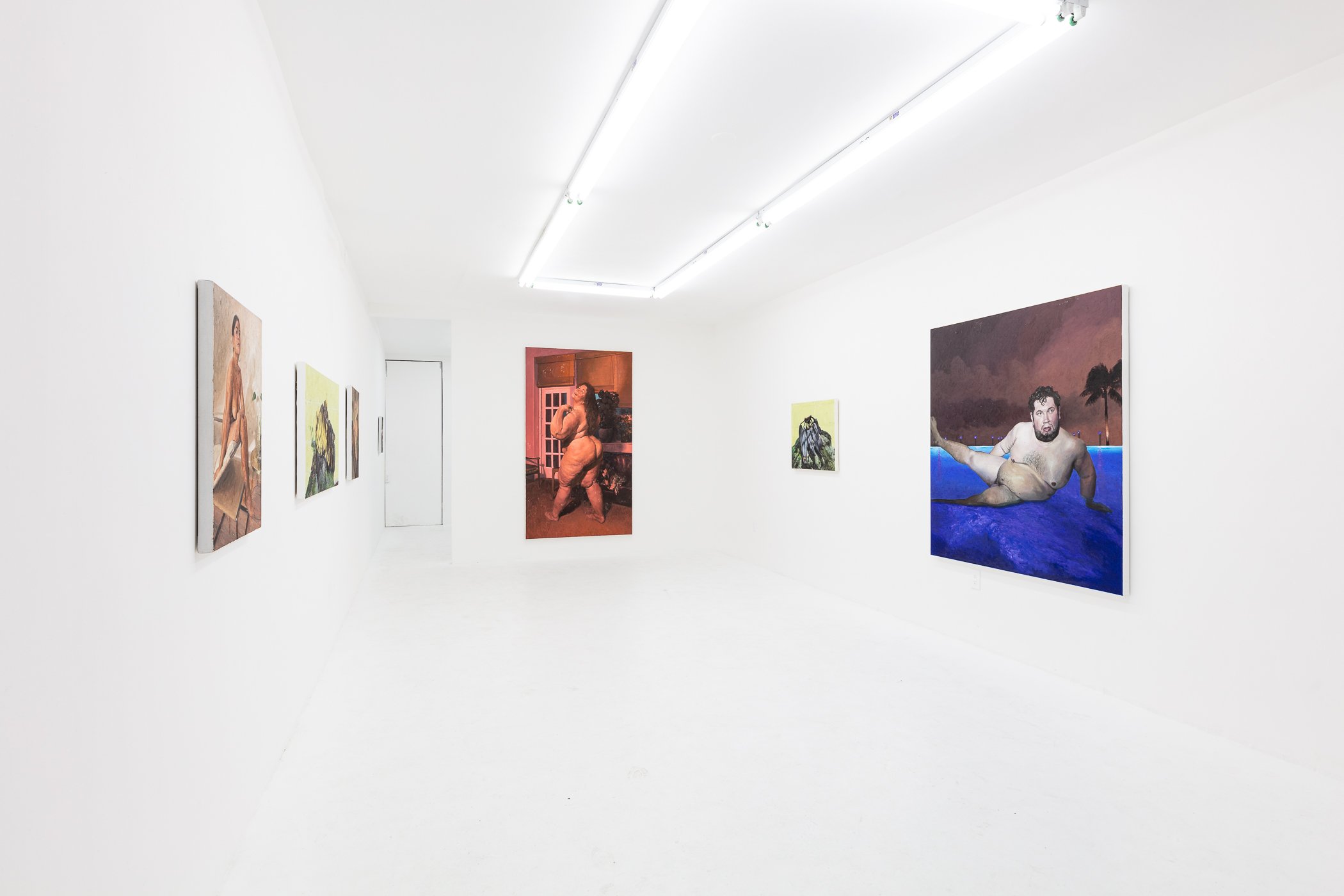
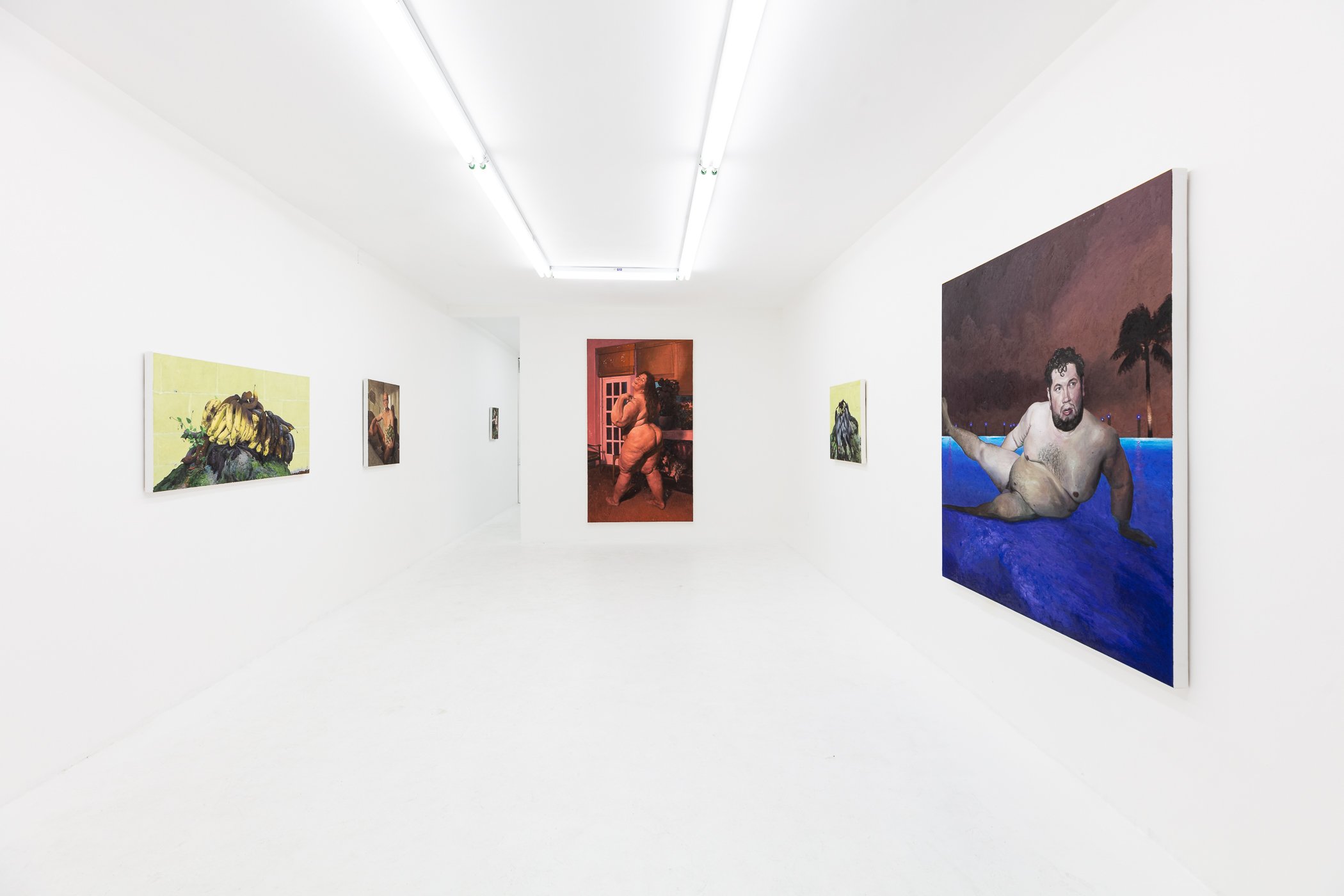
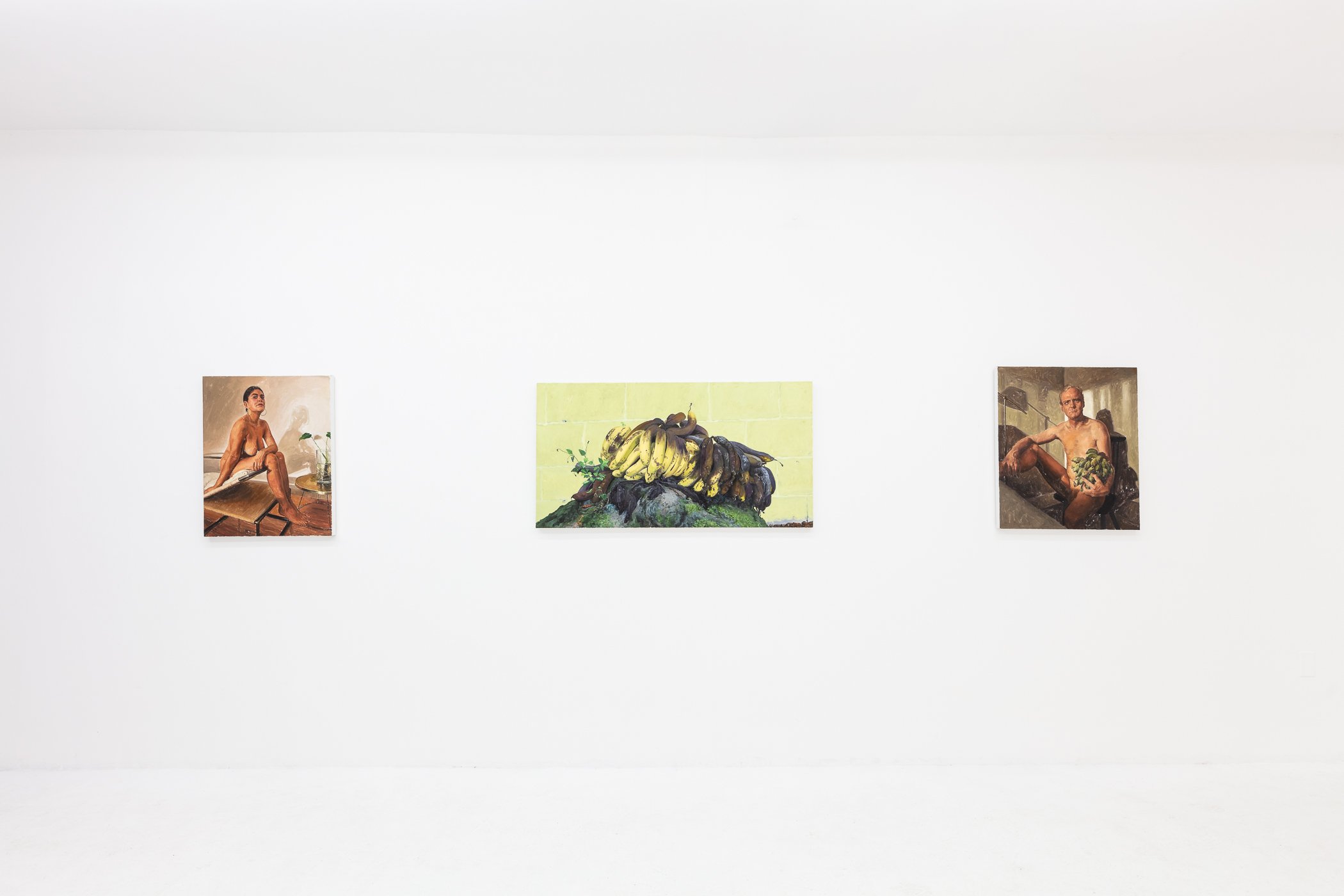
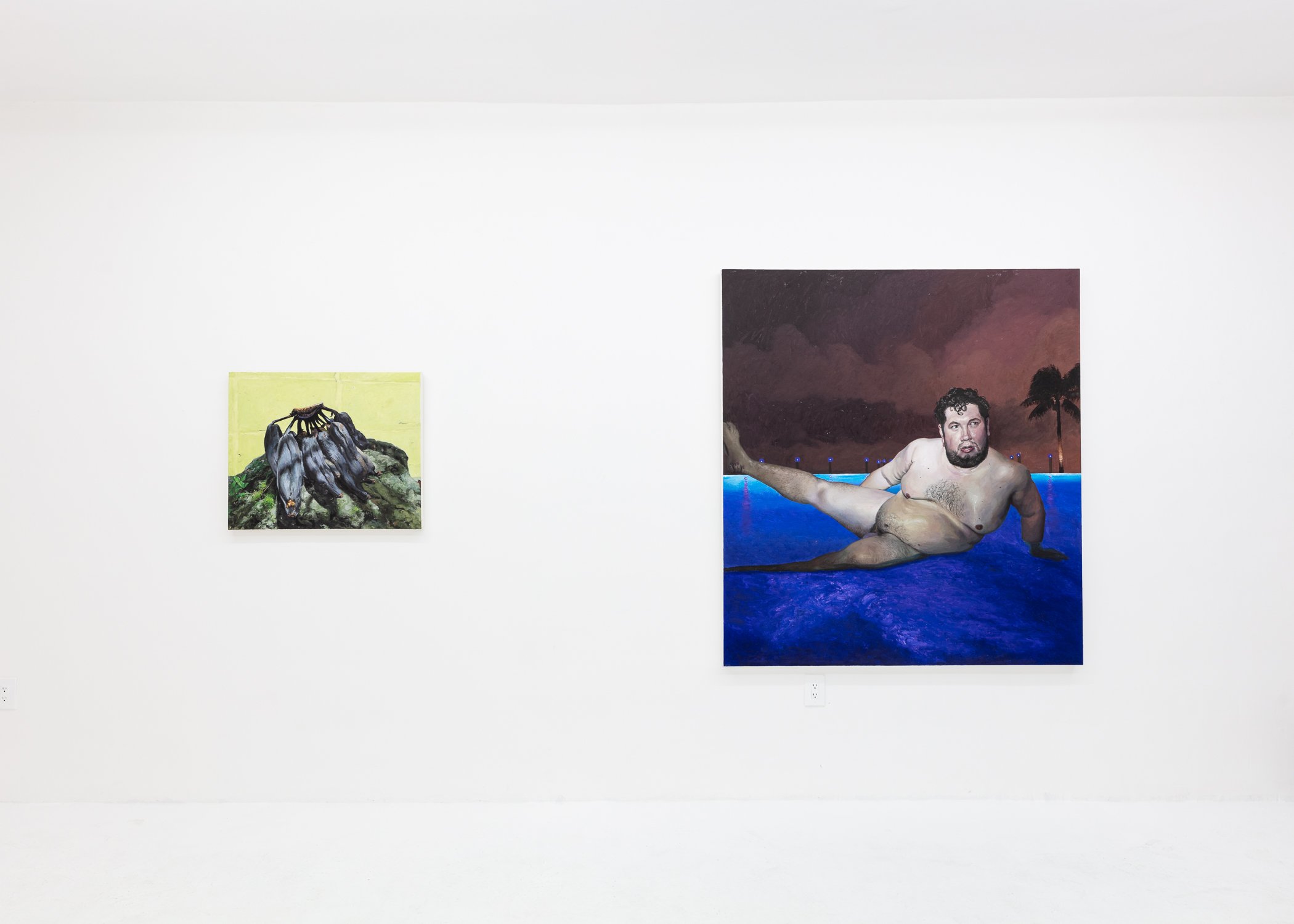
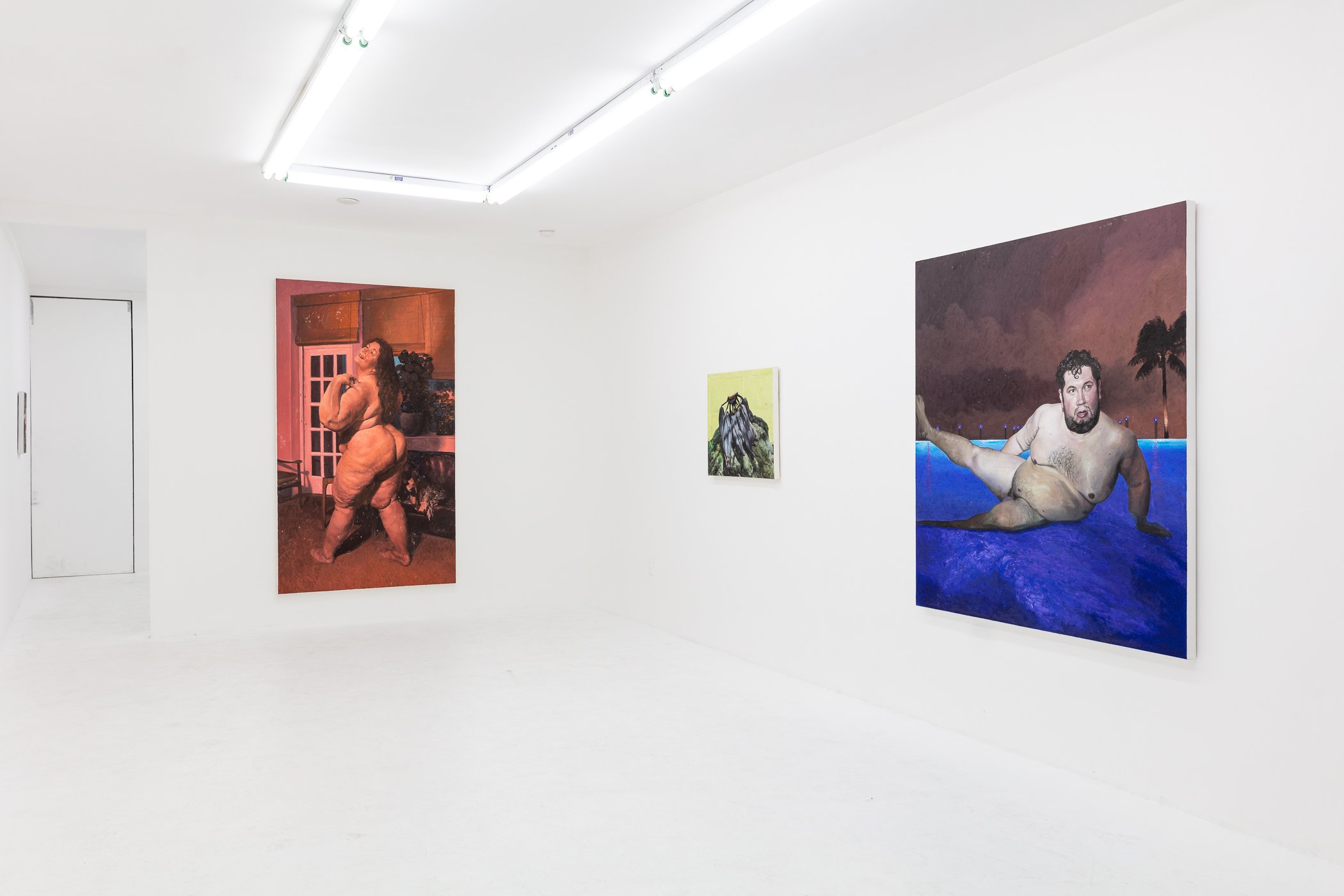
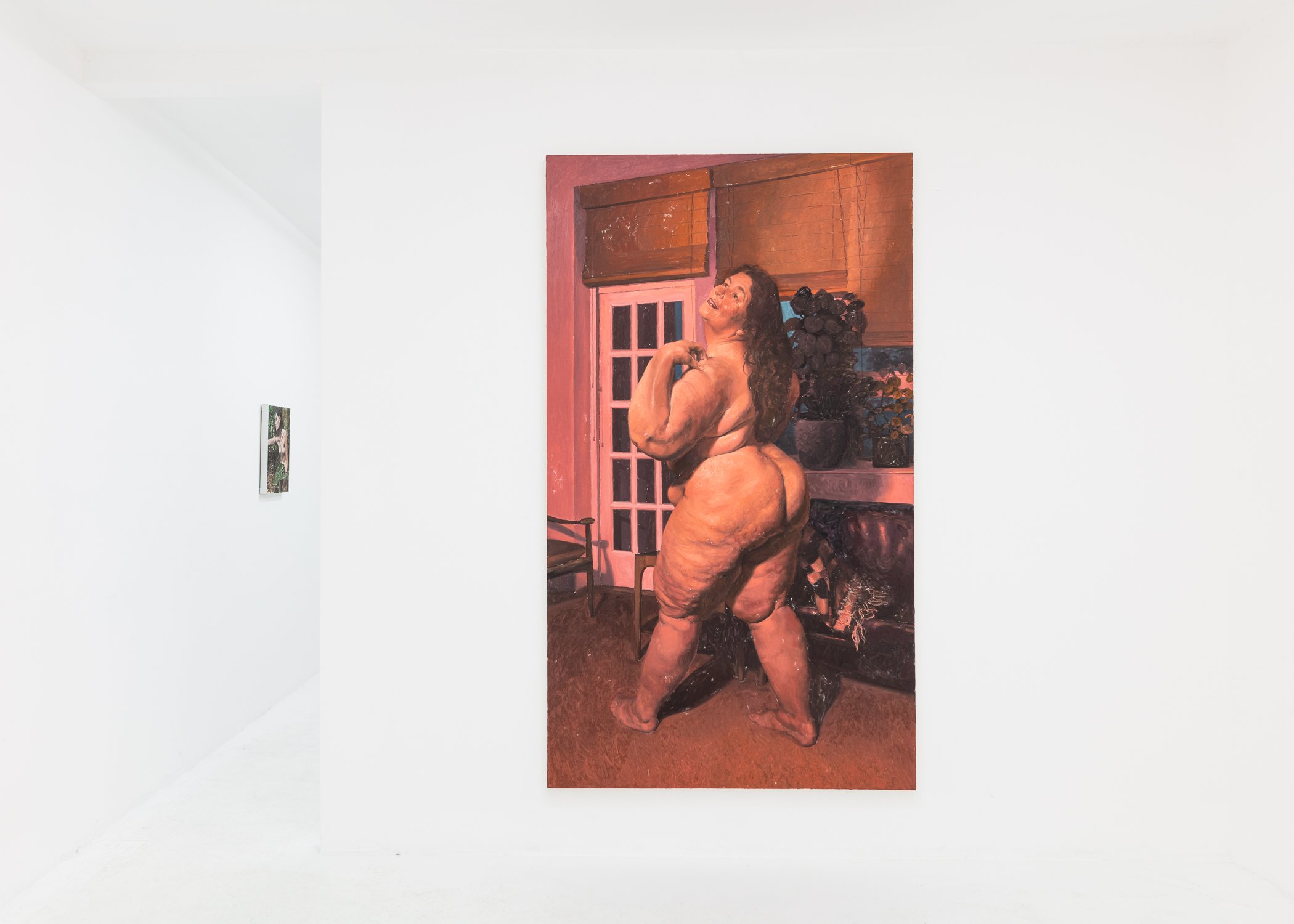
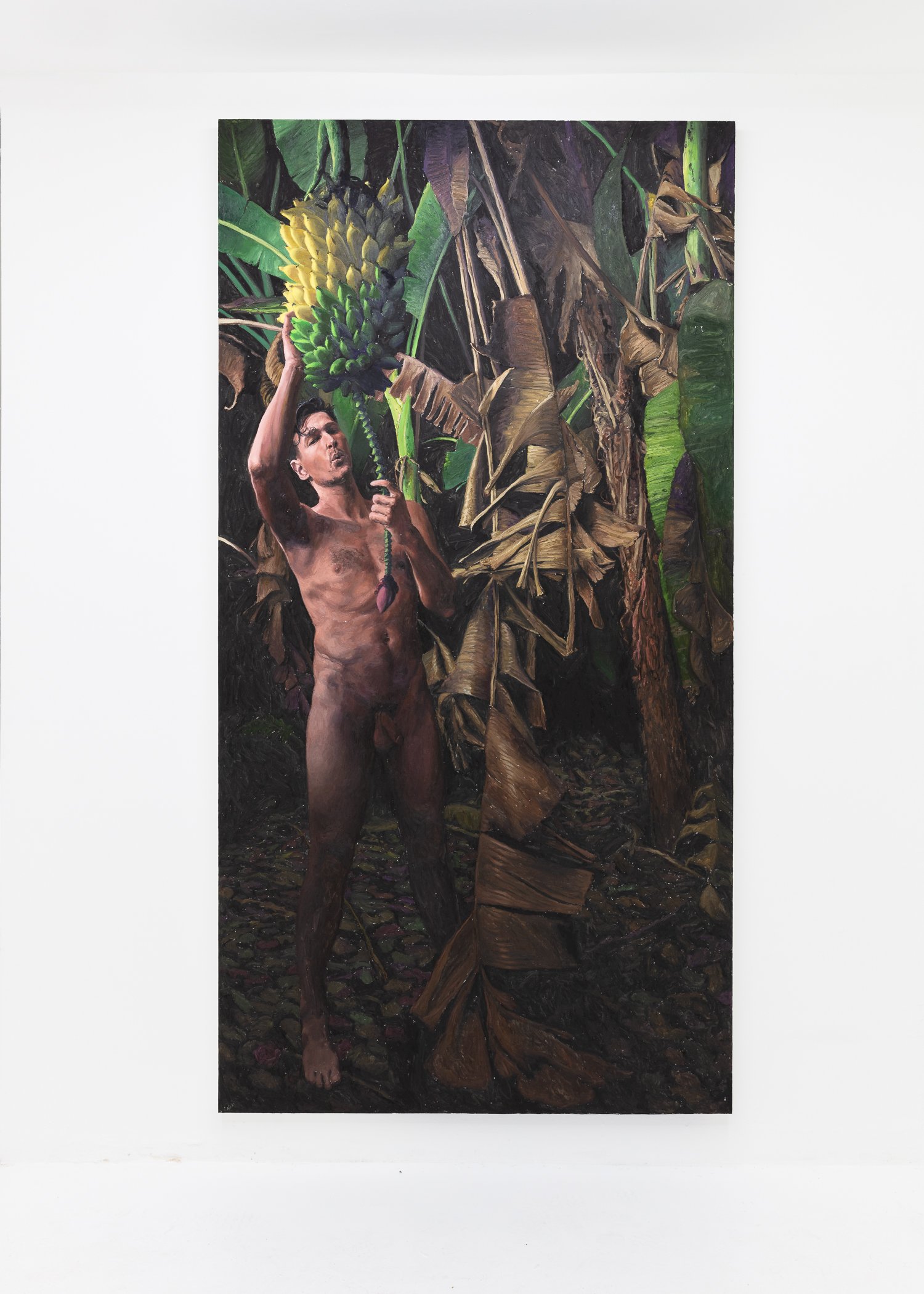
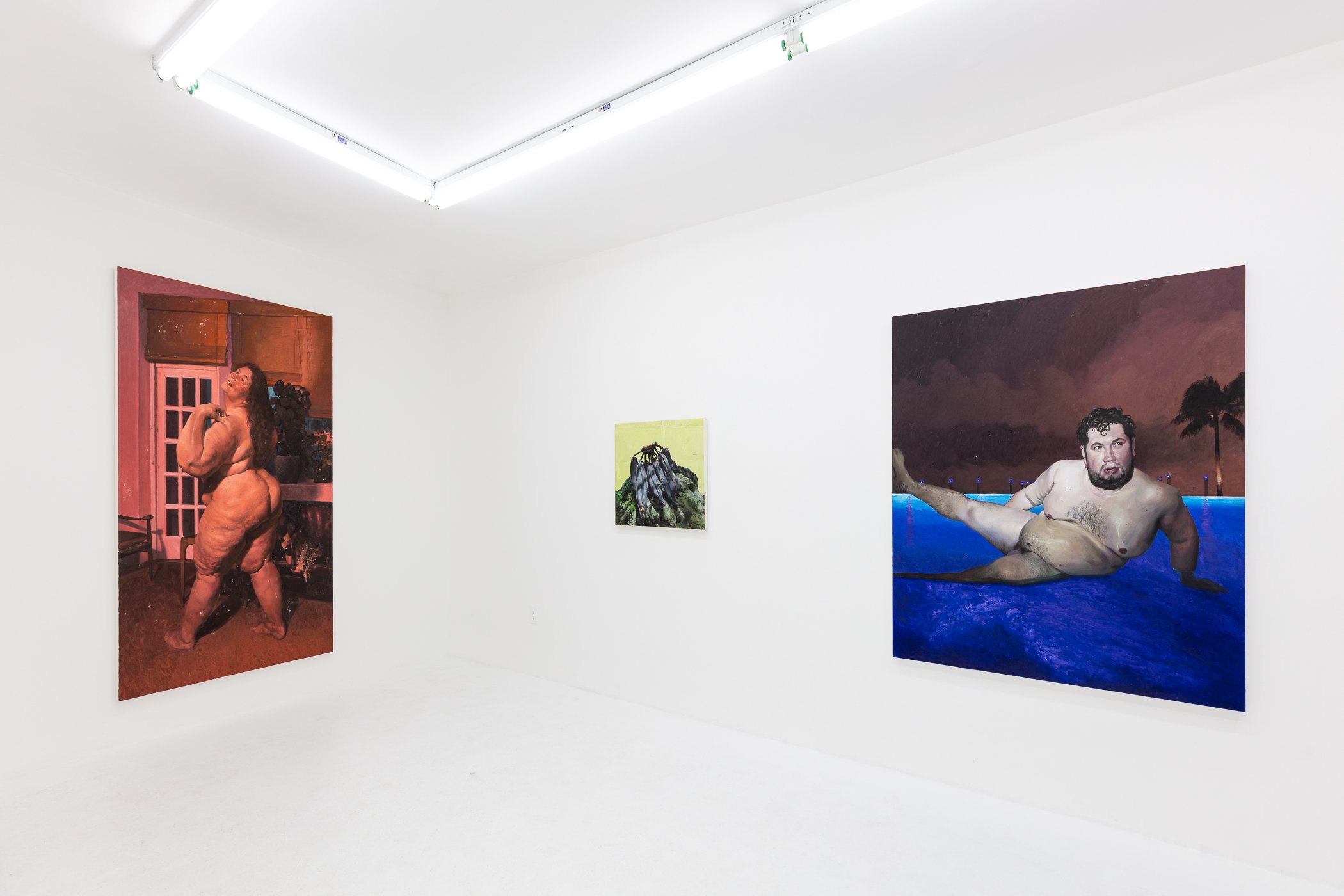
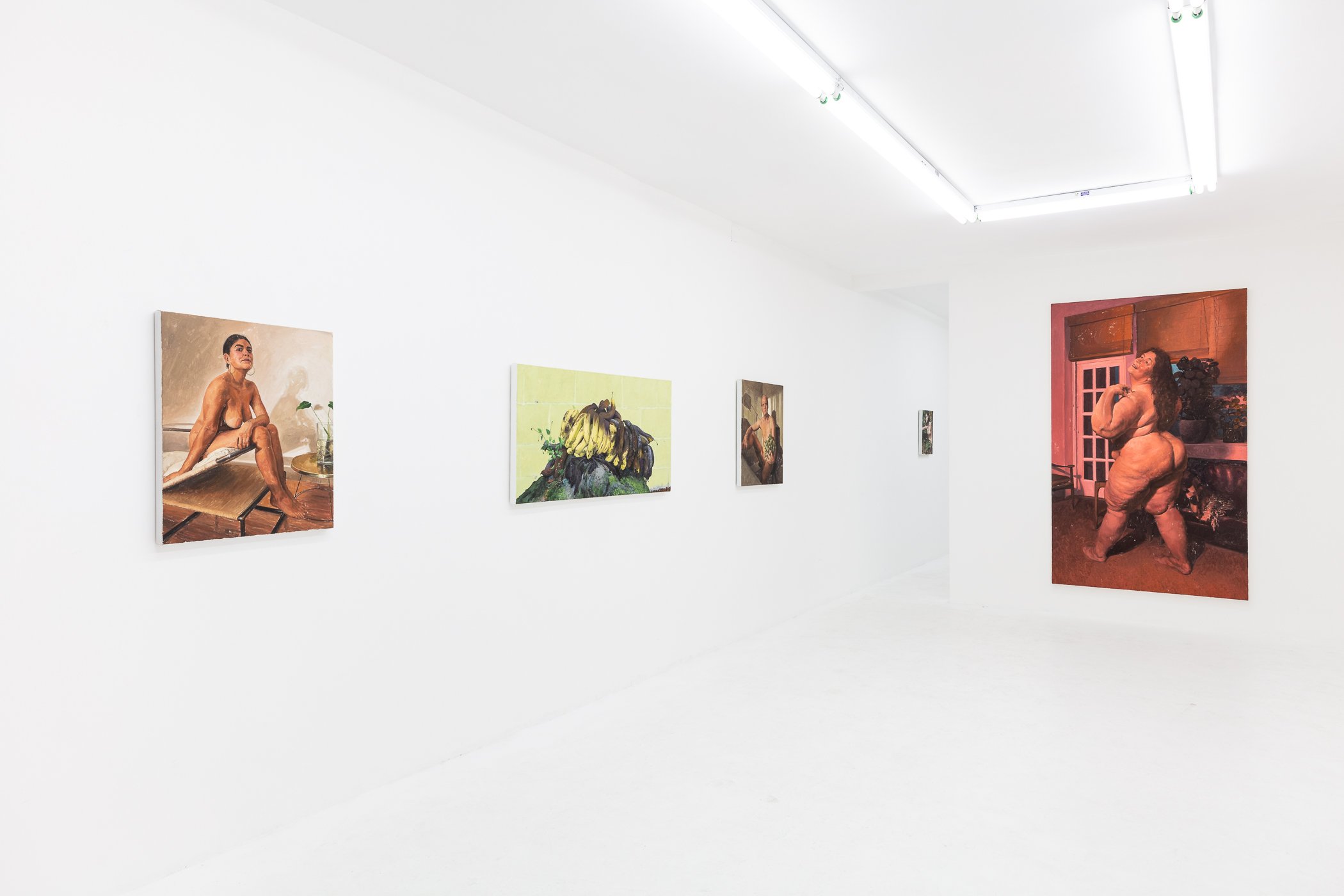
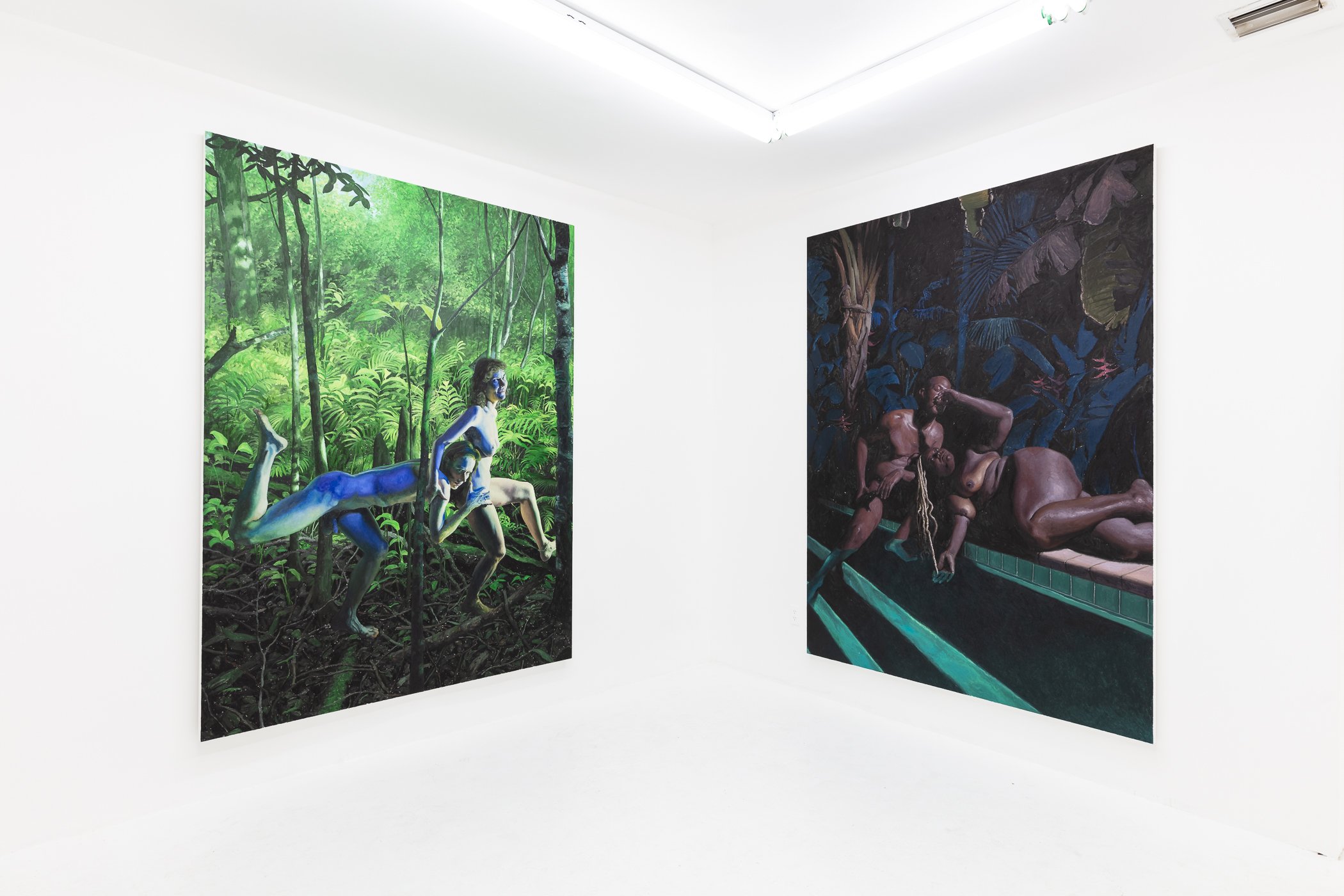
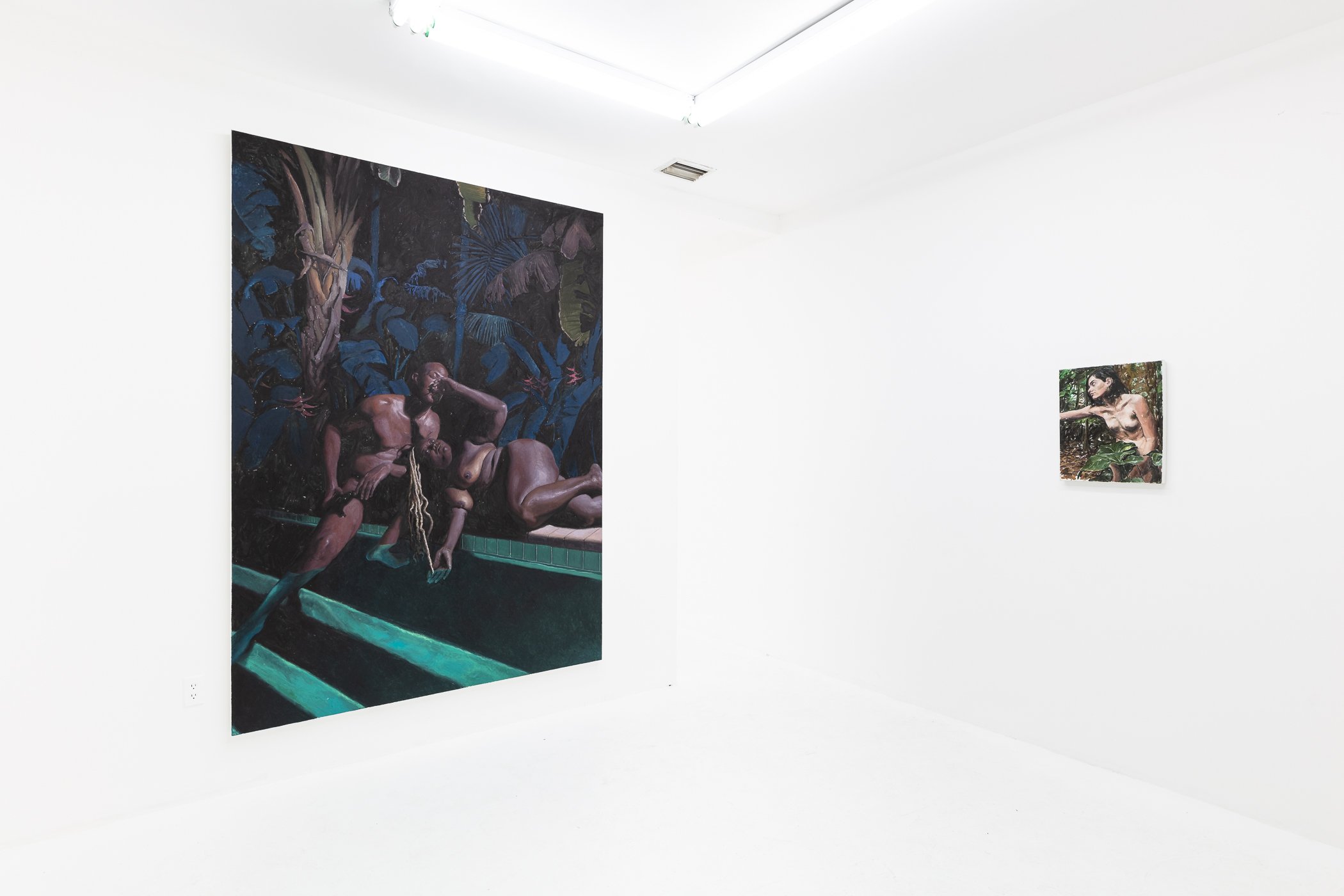
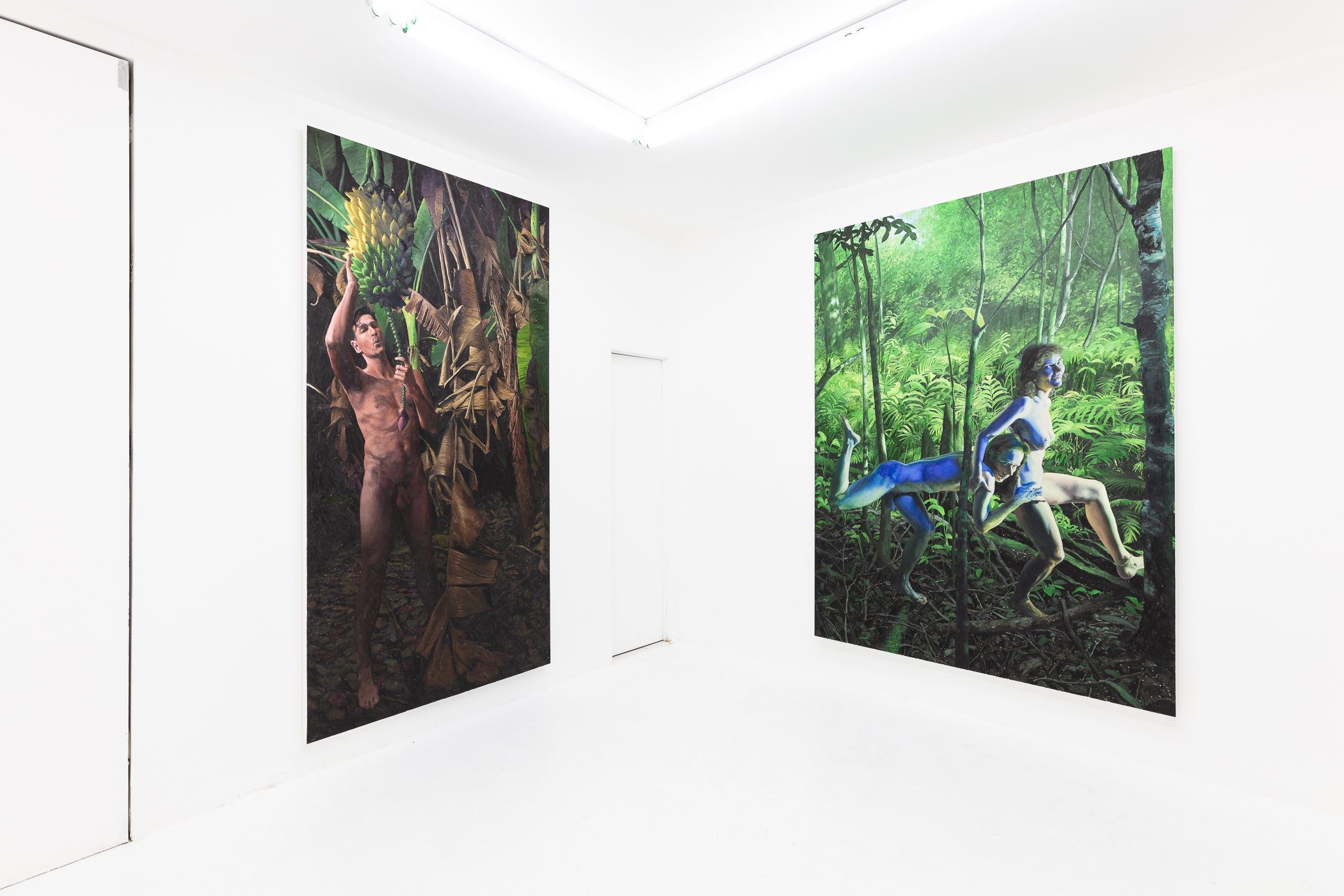
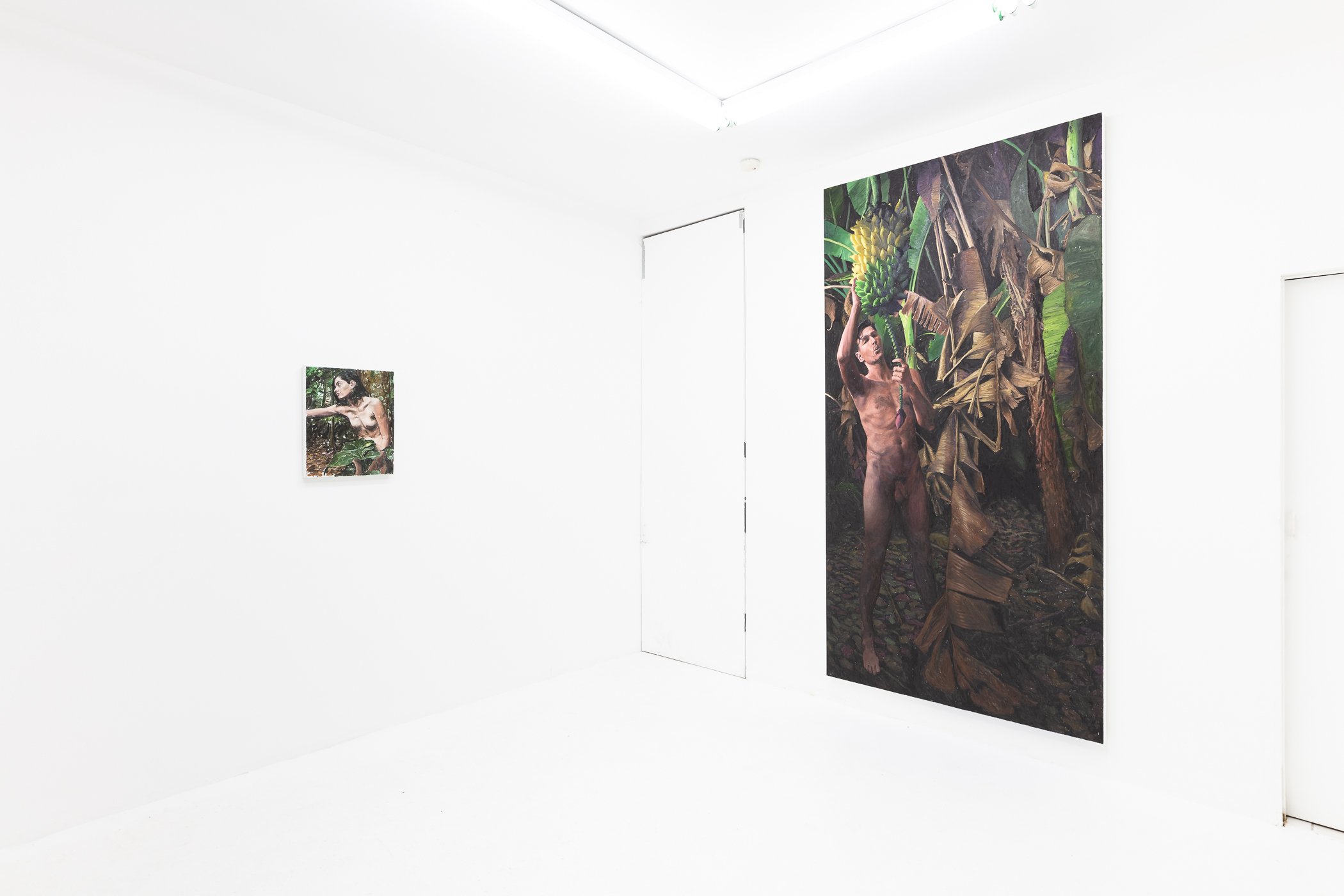
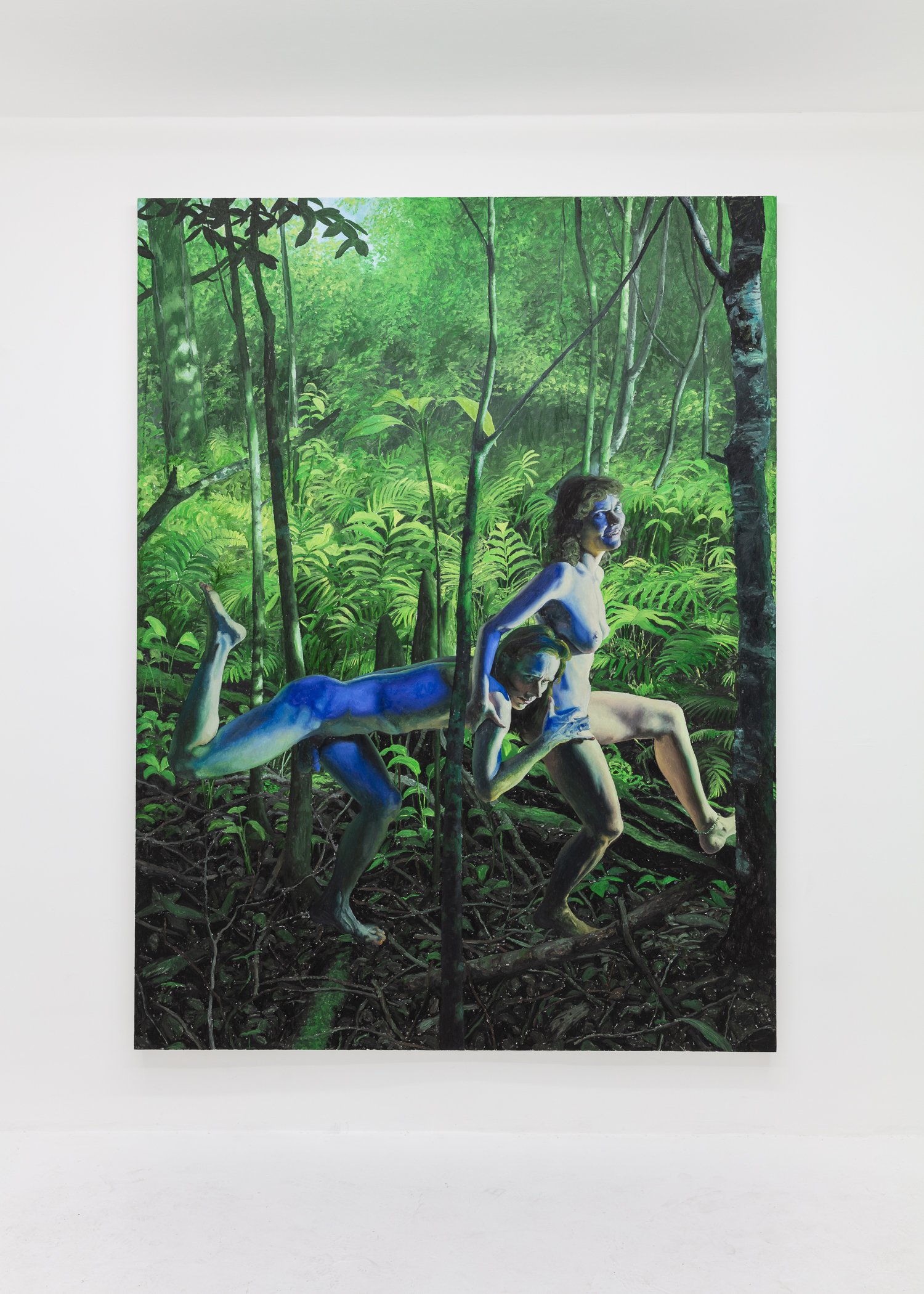
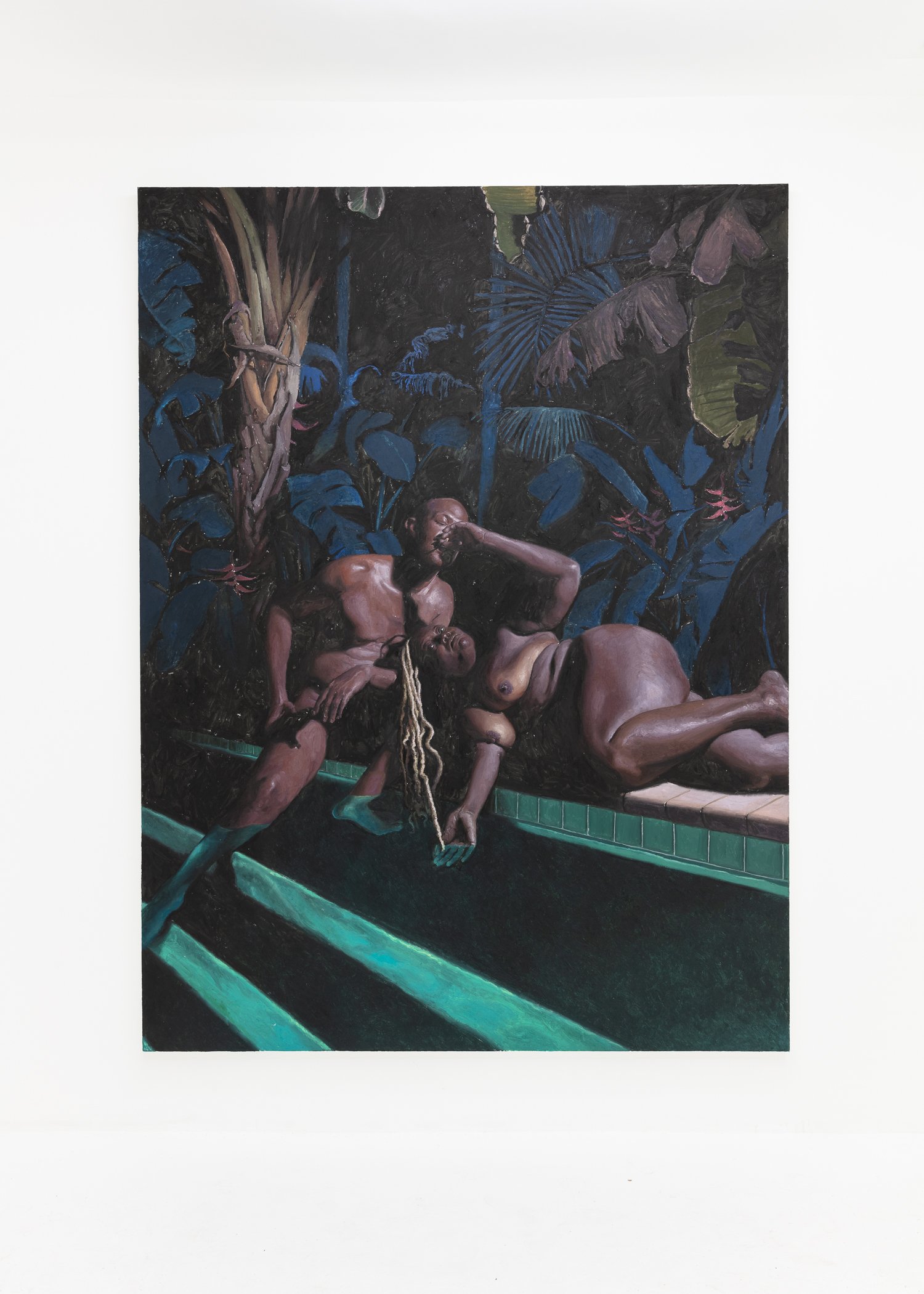
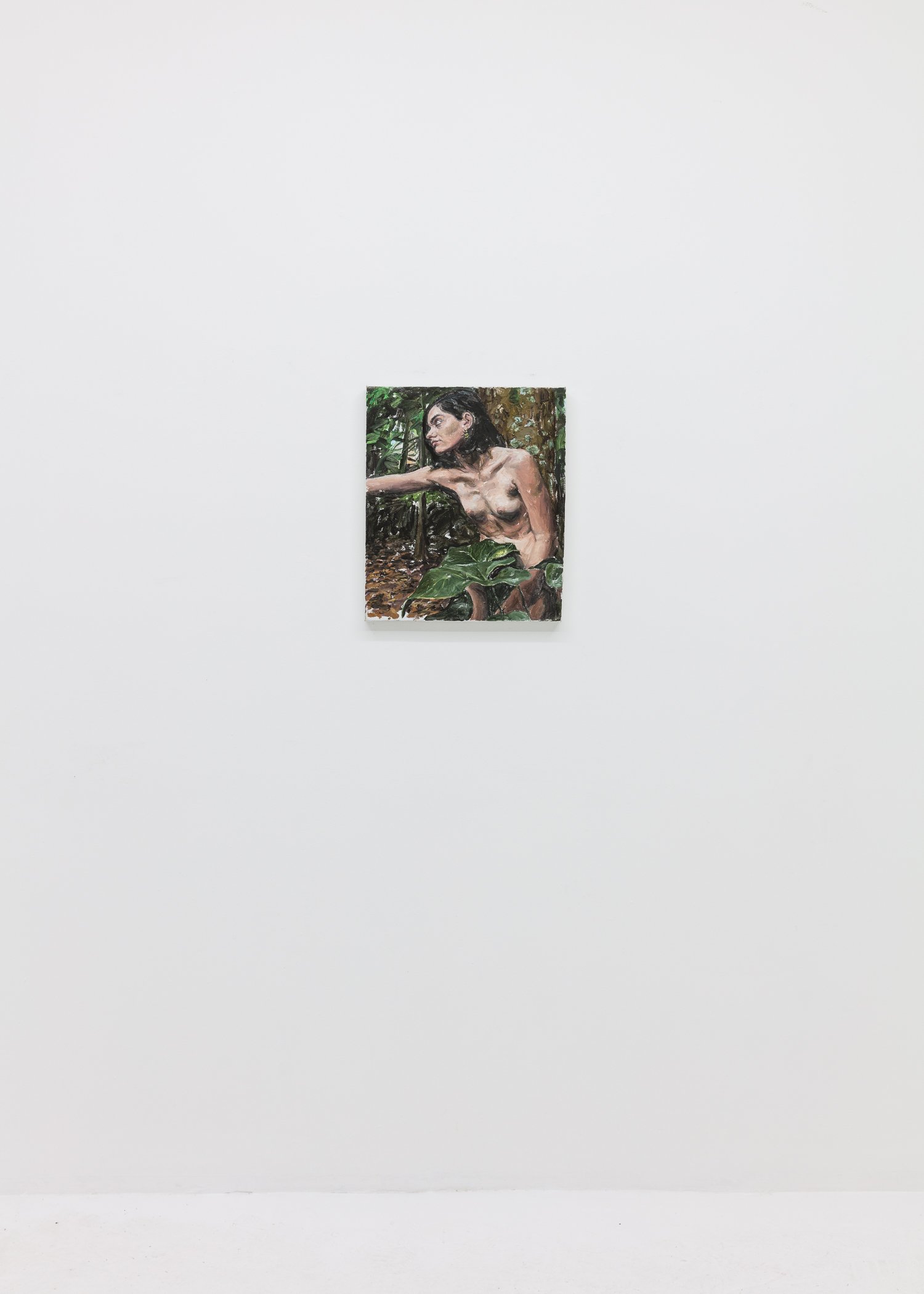
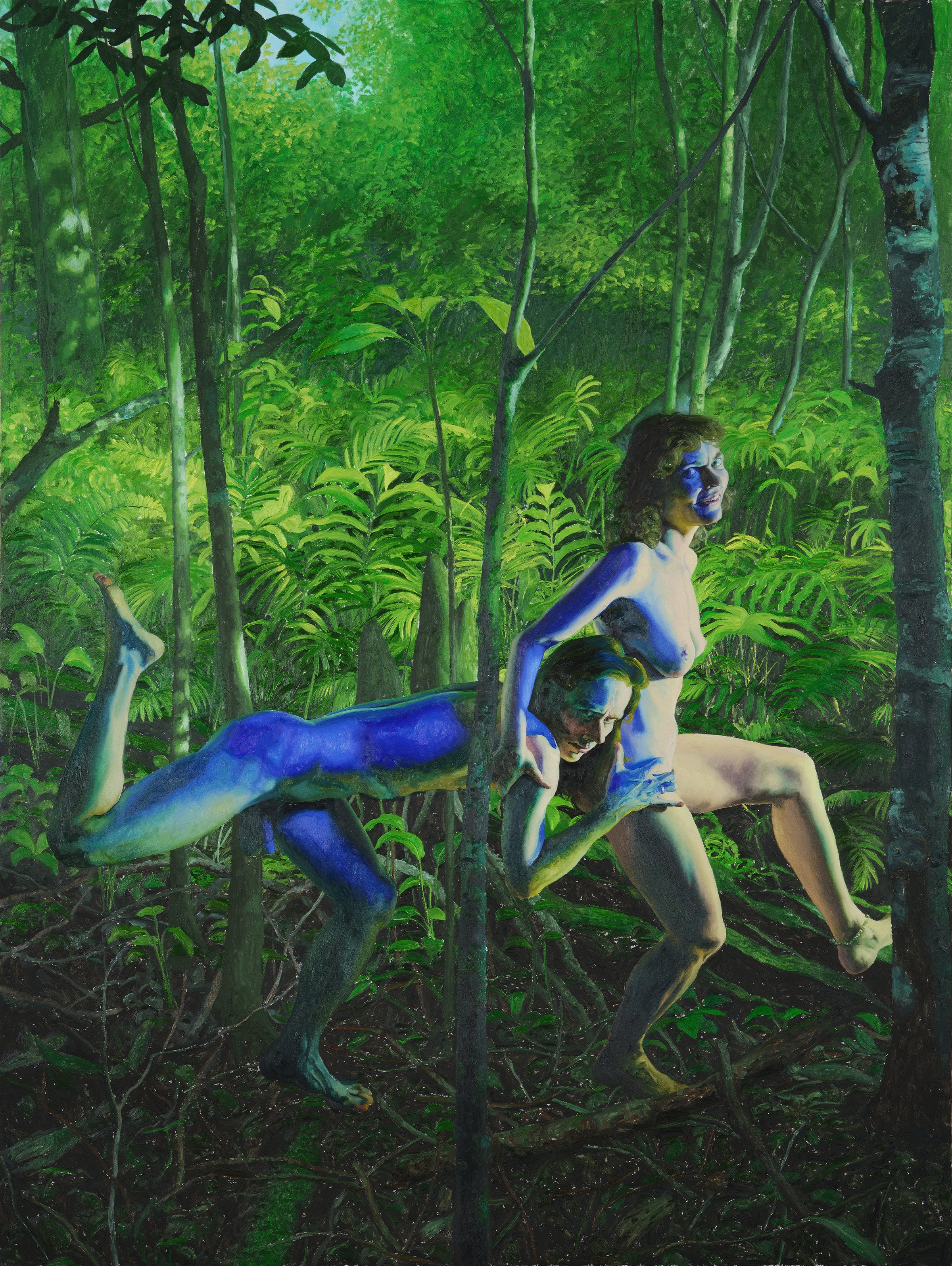
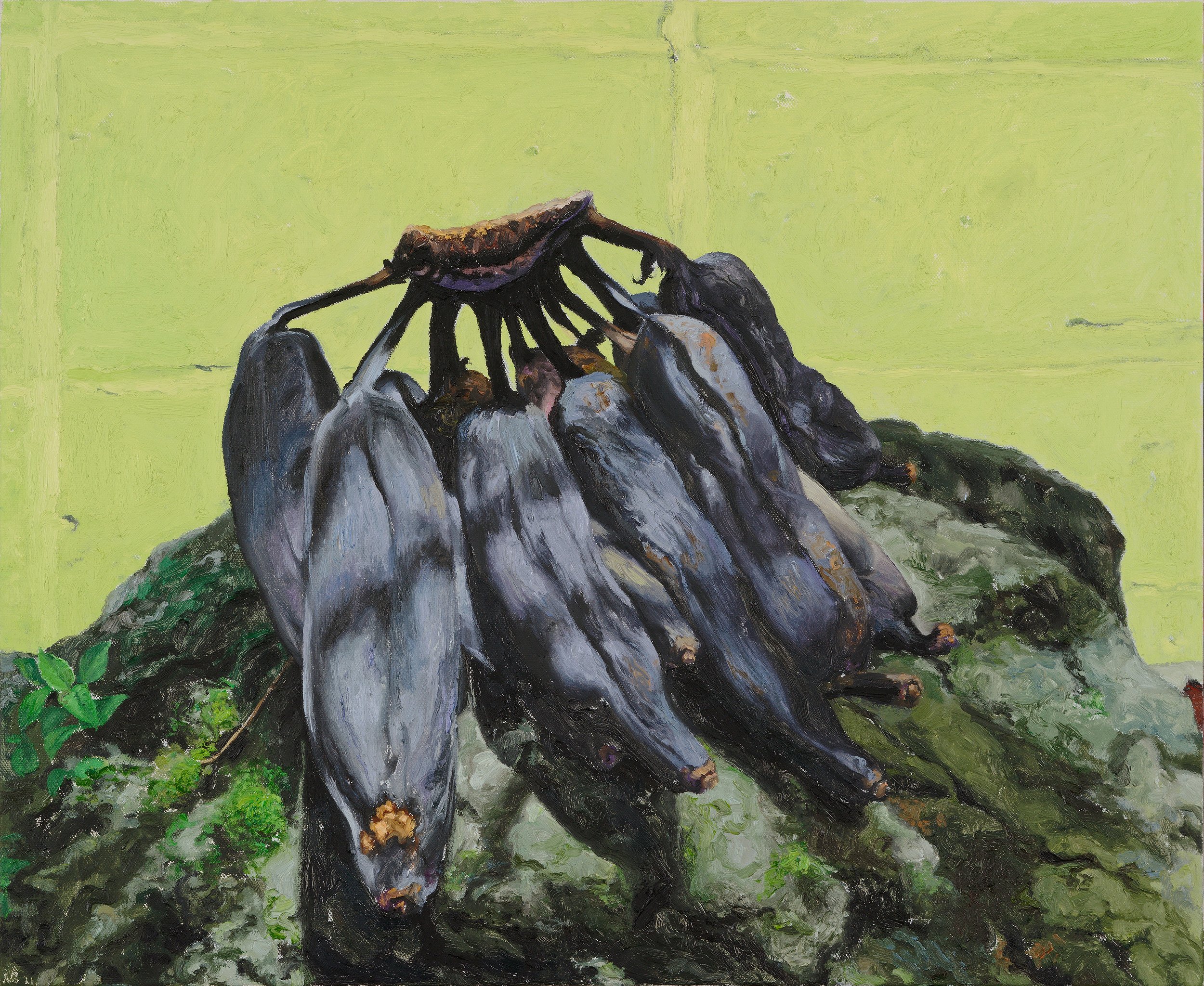

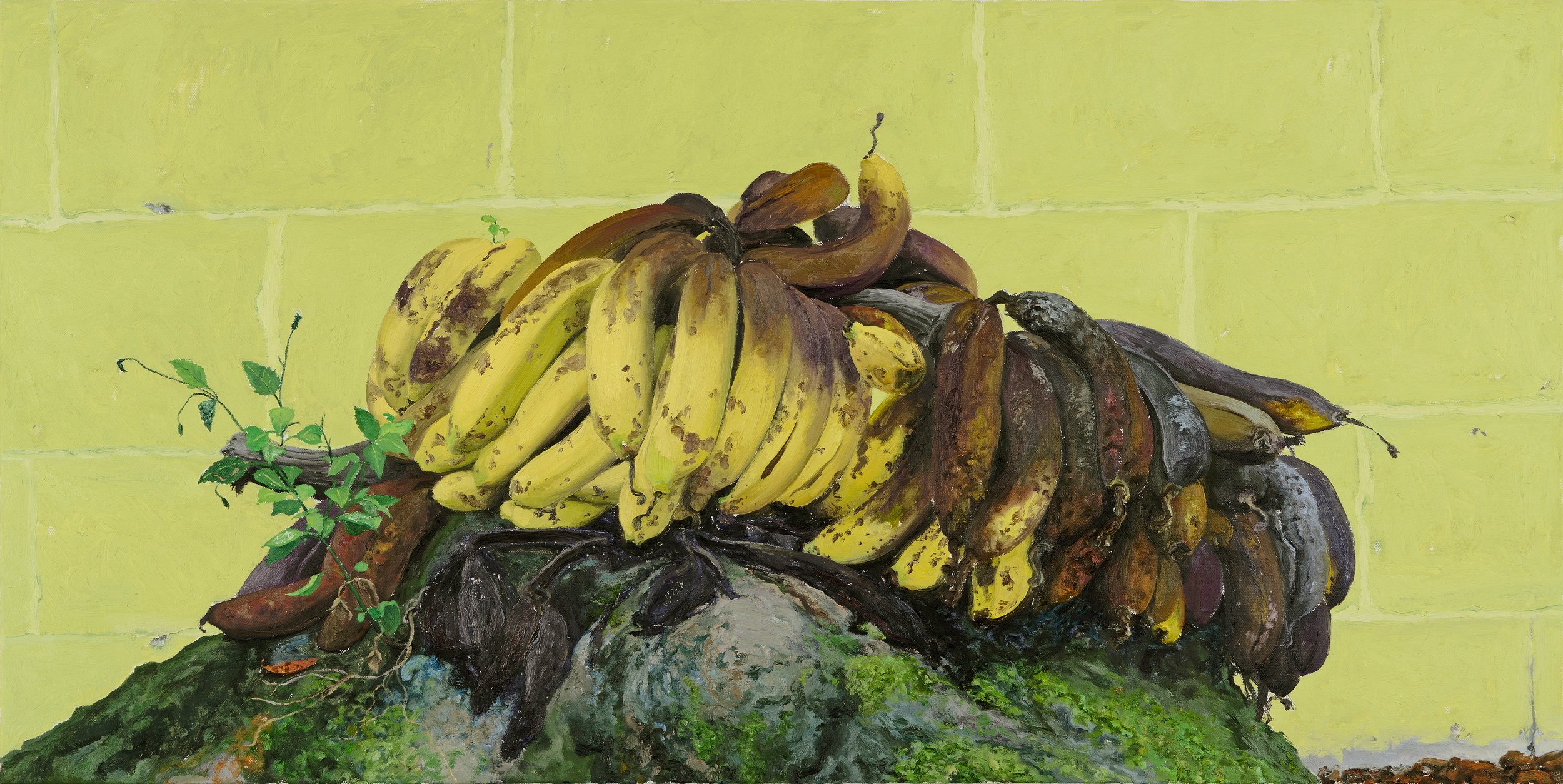
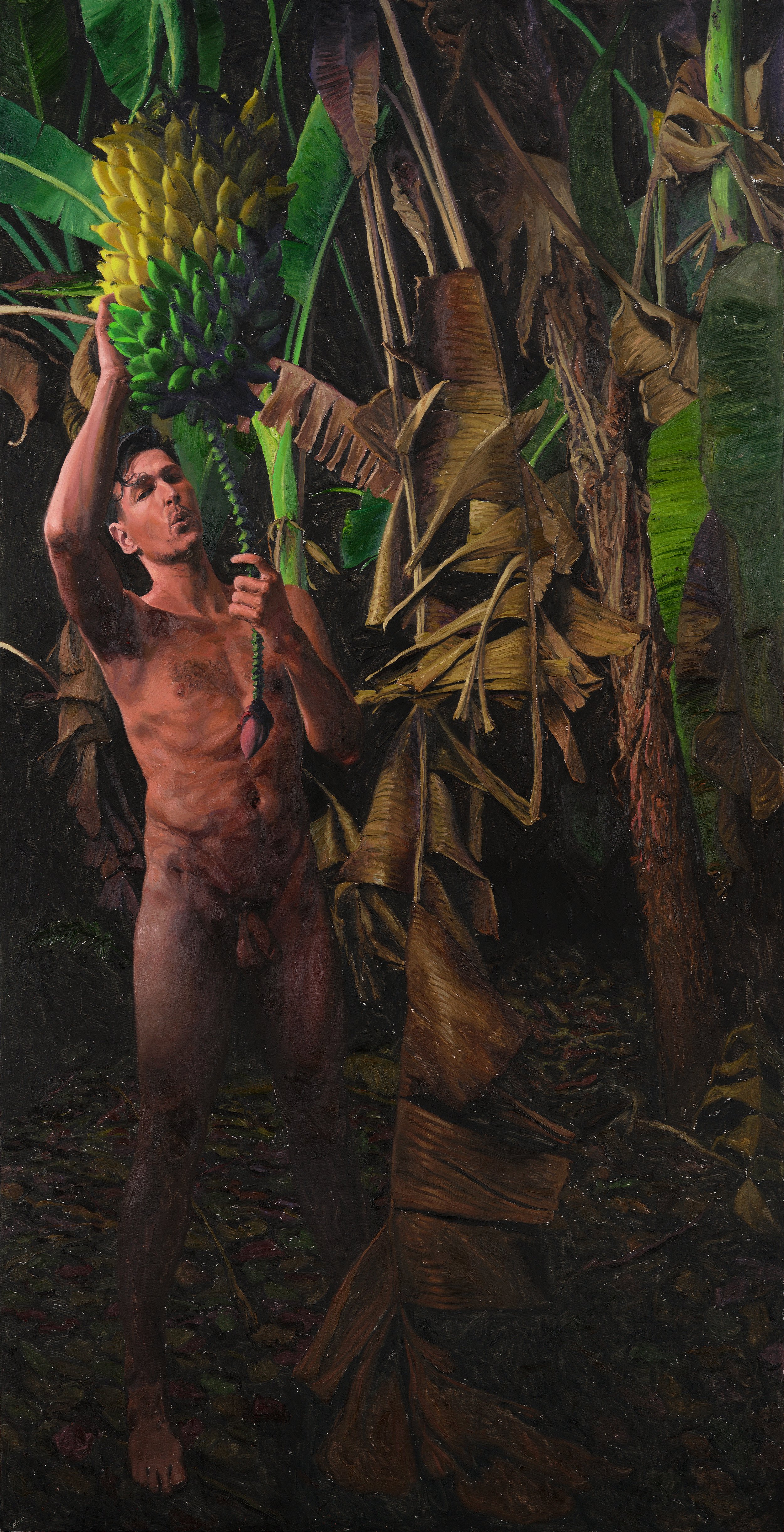
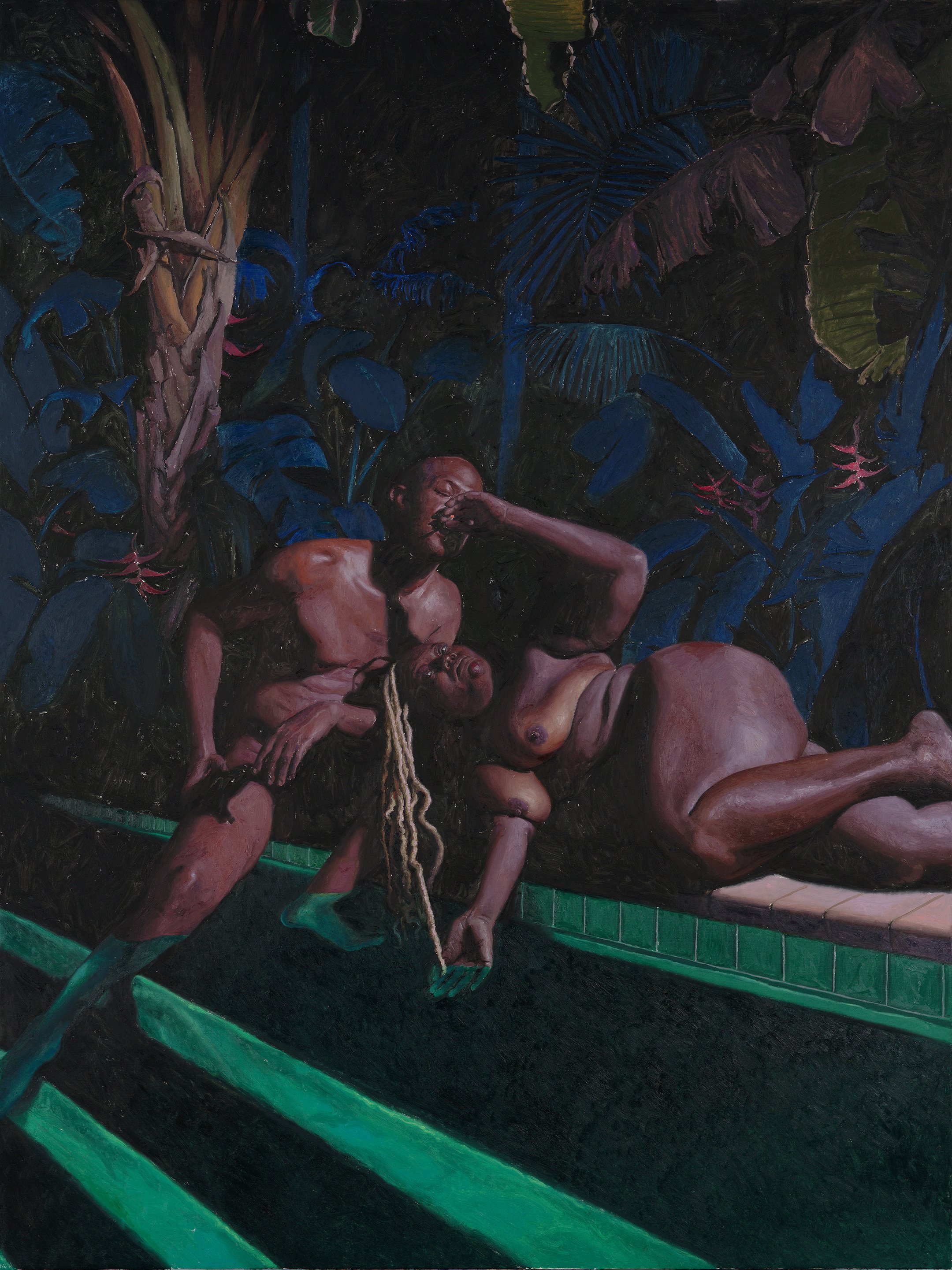

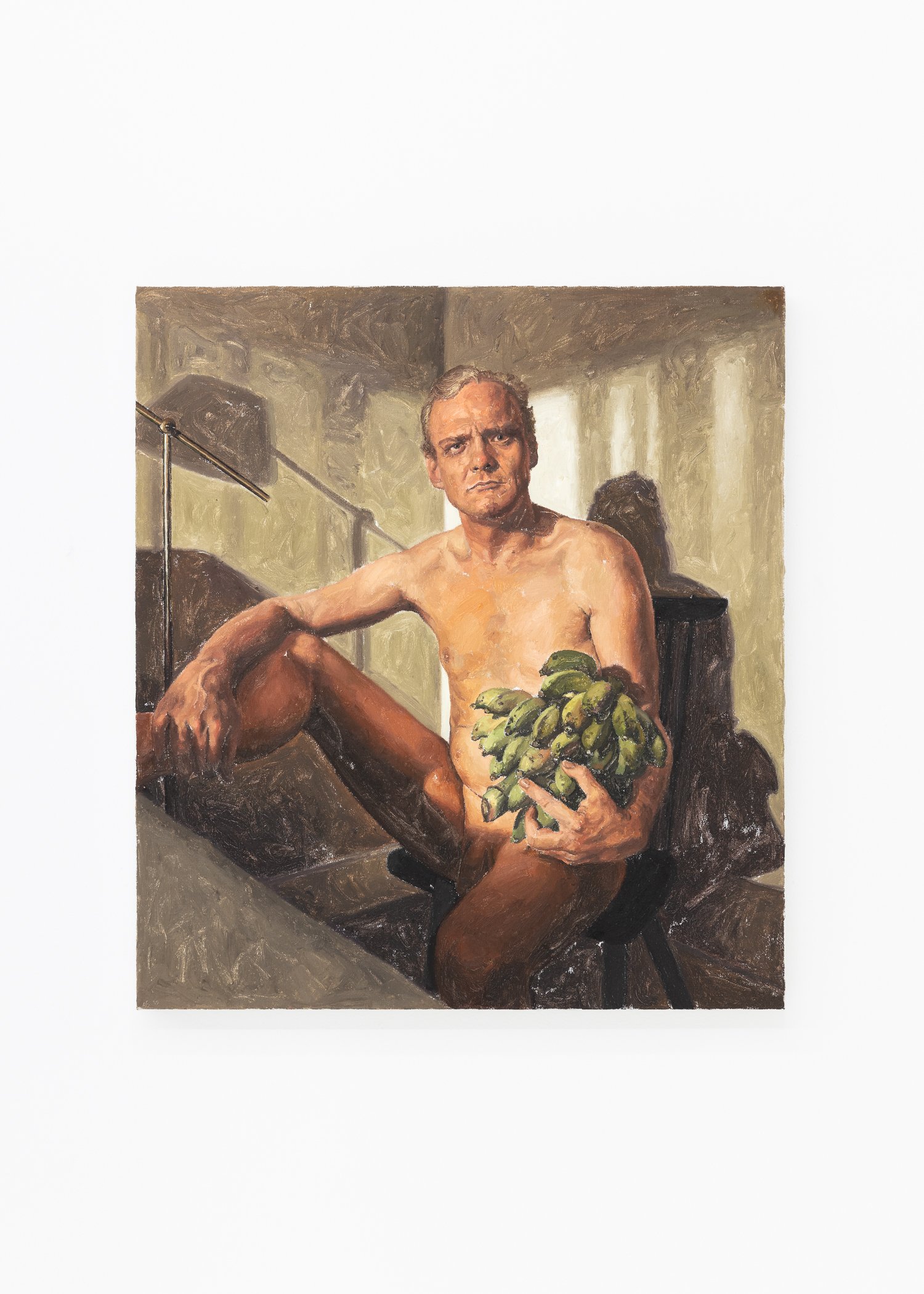
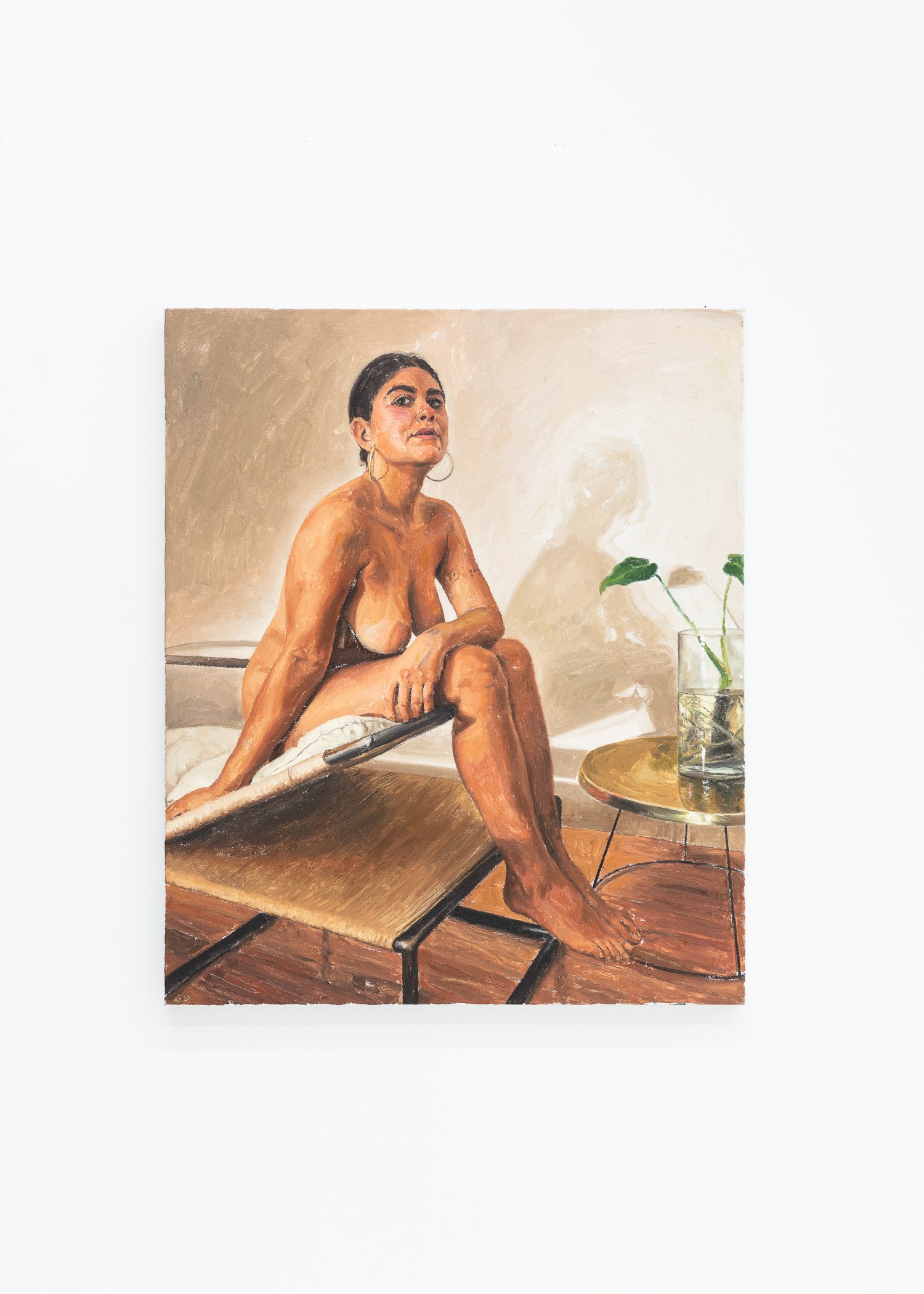
Your Custom Text Here
June 5th- July 6th, 2022
OPENING RECEPTION: SUNDAY, JUNE 5TH 6-8.30 PM
Bananas haven’t always taken their current form. Trace their ancestors back a few hundred years and you’ll find fruits that were smaller, more rotund, and less edible. It was only through the push and pull symbiotic process of human domestication that bananas transformed into their modern shape. The trajectory of the banana is not dissimilar to the trajectory of a portrait.
A portrait is something of a blind psychic handshake between the painter and their subject, where the conscious and subconscious desires of both parties find themselves as present in the final painting as the image of the subject itself. In Banana Ester & Petrichor, Aramis Gutierrez explores this inherent subjectivity, creating narratives that work as statements on the nature of friendship, grief, beauty, and sadness.
We can see his interest in deconstructing the subjectivity of portraiture in Willy Splishy Splashy, a painting showing Gutierrez’s friend Willy, posing nude in a Miami pool. Willy’s legs are spread delicately, with one resting in the water, and the other pushed upwards to the sky, in an almost balletic gesture. The moment depicted is flattering and joyous but is represented with a sly nuance - upon close inspection another aspect of the moment reveals itself - at the edge of the canvas an assistant’s hand can be seen lifting Willy’s leg, presumably to maintain his striking pose.
Gutierrez’s choice to paint the artifice of the moment directly onto the canvas reveals the staged nature of the portrait in a manner recalling the conceptual framework of Epic Theater1 : We are looking at that portrait’s construction. We become alienated from the classical narrative of the portrait, and, perhaps, consider Willy not just as an immortal, majestic being, but also as a human, full of joy, humor, and pain. This disarming honesty works its way through every painting in the series.
Gutierrez reminds us of the constructed nature of these portraits, whether it be through his highly stylized cinematic lighting, his unabashed commitment to capturing the dark, lurid aesthetic of South Florida, or through his unusually ‘relaxed’ mise en scène
It is sometimes said that portraits are possessed objects - that every portrait ever painted is haunted by time, by history, by the subject of the portrait itself. While that is certainly true of the works in Banana Ester & Petrichor; they are also haunted by something much more personal and localized - that thing that resides beneath the peel of the banana.
Aramis Gutierrez, b. Pittusburgh, PA, 1975. He has presented his work at the Institute of Contemporary Art Miami, Miami; Galerie Balice Hertling, Paris; Orlando Museum of Art; The Frost Museum, Miami, FL; Miami Museum of Art, Miami FL; Binghamton University, Binghamton, NY; Guccivuitton, NADA Miami Beach, FL; among other places.
He was awarded the South Florida Cultural Consortium Award; Kaleidoscope Magazine Instagram Residency, 2015; The Deering Estate Invitational Studio Residency Program among other distinctions.
Gutierrez cofounded the artist run space GUCCIVUITTON with artists Loriel Beltran and Domingo Castillo, later partnering with architect/designer, Jonathan Gonzalez.
His work is part of the Collection of the Institute of Contemporary Art Miami, among others.
Text by Hunter Osking
Edits by Diego Singh
————————————————————————-
1 Epic Theatre, German Episches Theater, is a form of didactic drama presenting a series of loosely connected scenes that avoid illusion and often interrupt the story line to address the audience directly with analysis, argument, or documentation. Epic theatre is now most often associated with the dramatic theory and practice evolved by the playwright-director Bertolt Brecht in Germany from the 1920s onward. Its dramatic antecedents include the episodic structure and didactic nature of the pre-Expressionist drama of the German playwright Frank Wedekind and the Expressionist theatre of the German directors Erwin Piscator (with whom Brecht collaborated in 1927) and Leopold Jessner, both of whom made exuberant use of the technical effects that came to characterize epic theatre.
June 5th- July 6th, 2022
OPENING RECEPTION: SUNDAY, JUNE 5TH 6-8.30 PM
Bananas haven’t always taken their current form. Trace their ancestors back a few hundred years and you’ll find fruits that were smaller, more rotund, and less edible. It was only through the push and pull symbiotic process of human domestication that bananas transformed into their modern shape. The trajectory of the banana is not dissimilar to the trajectory of a portrait.
A portrait is something of a blind psychic handshake between the painter and their subject, where the conscious and subconscious desires of both parties find themselves as present in the final painting as the image of the subject itself. In Banana Ester & Petrichor, Aramis Gutierrez explores this inherent subjectivity, creating narratives that work as statements on the nature of friendship, grief, beauty, and sadness.
We can see his interest in deconstructing the subjectivity of portraiture in Willy Splishy Splashy, a painting showing Gutierrez’s friend Willy, posing nude in a Miami pool. Willy’s legs are spread delicately, with one resting in the water, and the other pushed upwards to the sky, in an almost balletic gesture. The moment depicted is flattering and joyous but is represented with a sly nuance - upon close inspection another aspect of the moment reveals itself - at the edge of the canvas an assistant’s hand can be seen lifting Willy’s leg, presumably to maintain his striking pose.
Gutierrez’s choice to paint the artifice of the moment directly onto the canvas reveals the staged nature of the portrait in a manner recalling the conceptual framework of Epic Theater1 : We are looking at that portrait’s construction. We become alienated from the classical narrative of the portrait, and, perhaps, consider Willy not just as an immortal, majestic being, but also as a human, full of joy, humor, and pain. This disarming honesty works its way through every painting in the series.
Gutierrez reminds us of the constructed nature of these portraits, whether it be through his highly stylized cinematic lighting, his unabashed commitment to capturing the dark, lurid aesthetic of South Florida, or through his unusually ‘relaxed’ mise en scène
It is sometimes said that portraits are possessed objects - that every portrait ever painted is haunted by time, by history, by the subject of the portrait itself. While that is certainly true of the works in Banana Ester & Petrichor; they are also haunted by something much more personal and localized - that thing that resides beneath the peel of the banana.
Aramis Gutierrez, b. Pittusburgh, PA, 1975. He has presented his work at the Institute of Contemporary Art Miami, Miami; Galerie Balice Hertling, Paris; Orlando Museum of Art; The Frost Museum, Miami, FL; Miami Museum of Art, Miami FL; Binghamton University, Binghamton, NY; Guccivuitton, NADA Miami Beach, FL; among other places.
He was awarded the South Florida Cultural Consortium Award; Kaleidoscope Magazine Instagram Residency, 2015; The Deering Estate Invitational Studio Residency Program among other distinctions.
Gutierrez cofounded the artist run space GUCCIVUITTON with artists Loriel Beltran and Domingo Castillo, later partnering with architect/designer, Jonathan Gonzalez.
His work is part of the Collection of the Institute of Contemporary Art Miami, among others.
Text by Hunter Osking
Edits by Diego Singh
————————————————————————-
1 Epic Theatre, German Episches Theater, is a form of didactic drama presenting a series of loosely connected scenes that avoid illusion and often interrupt the story line to address the audience directly with analysis, argument, or documentation. Epic theatre is now most often associated with the dramatic theory and practice evolved by the playwright-director Bertolt Brecht in Germany from the 1920s onward. Its dramatic antecedents include the episodic structure and didactic nature of the pre-Expressionist drama of the German playwright Frank Wedekind and the Expressionist theatre of the German directors Erwin Piscator (with whom Brecht collaborated in 1927) and Leopold Jessner, both of whom made exuberant use of the technical effects that came to characterize epic theatre.